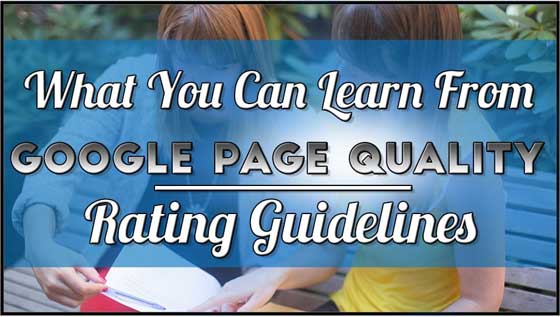Have you ever wanted to go inside the mind of Google to figure out exactly what makes one page more valuable than another? If so, then the leak of Google’s Page Quality Rating Guidelines is the answer. This 160-page document, released in March 2014, outlines what Search Quality Evaluators (raters) should look for when determining whether a webpage that is returned in search results for a particular keyword meets Google quality standards. In this post, we’re going to look at what you can learn from these guidelines and apply to your own website and webpages.
Table of Contents
ToggleYour Industry Determines the Level of Quality You Must Meet
Google classifies certain types of pages as YMYL – Your Money or Your Life. These are pages that could have an effect on a person’s wallet, health, or overall happiness. Pages that fall under these classifications must meet very high Page Quality rating standards. These pages include any that handle money (shopping, money transfers, bill pays, online banking, online store, etc.), financial information pages, medical information pages, legal information pages, and other topics that could affect well being and safety.
If your website falls under these categories, then your goal is to strive for the highest Page Quality rating as possible. Otherwise, your pages may not rank as highly in search results.
Content on Each Webpage Can Be Classified in Three Areas
Every page is broken down into one of three classifications:
Main Content
Every webpage, at the bare minimum, should have content that can be classified as Main Content. Main Content is the content that achieves the page’s purpose. For example, if the webpage is a tutorial on how to choose a car, then the Main Content of the page would consist of videos, reviews, and text that helps a person choose a car to buy.
Supplementary Content
Supplementary Content Quality Rating Guidelines is content on a page that doesn’t help achieve the webpage’s main purpose, but does help with user experience. If the webpage is a tutorial on how to choose a car, then Supplementary Content on the page may be links (such as a navigation bar or sidebar menu) to other pages with detailed reviews about specific cars. Most webpages have Supplementary Content, with exception to landing pages that do not have navigation back to the main website because they are focused on one specific goal (such as making a sale or converting a lead).
Advertisements / Monetization (Ads)
Advertisements / Monetization (Ads) is content that helps generate revenue on a page. For a webpage focused on how to choose a car, there might be banner ads for an automotive dealership or brand, or ads delivered through the Google Display Network. While the Page Quality Guidelines say that ads alone may not determine a webpage’s high or low quality rating, the webpage is responsible for the types of ads displayed (even if they are through networks like Google AdSense).
Raters are instructed to identify the Main Content first, and then identify Ads. The rest of the content on the webpage is to be considered Supplementary content. This means that you should focus on creating exceptional Main Content, and then make sure that your Ads are of high quality as well.
What Your Website Needs to Support Quality Content
Content is only half the battle when it comes to assuring a high Page Quality score. Raters must be able to find specific elements on your website in order to further determine the Page Quality score. These elements include the following:
- Your Homepage – Your website’s homepage should link to key pages that raters will be looking for, preferably in an easy-to-use navigation bar.
- Your About Page – Your website’s about page should clearly state who is creating webpage content. Content creators can include individuals, businesses, companies, and organizations.
- Your Contact Page – Your website should offer a contact us or customer service page, especially if it is a website that handles money (online stores, banks, credit card companies, etc.).
In addition to these specific pages, your website also needs to be well maintained. Raters are instructed to note if they come across broken links, images that don’t load, or other signs that the website is not running smoothly. In addition, if the website is one that is expected to maintain up-to-date content, such as a news site or a blog, then the recency of content can be a factor.
Your Website & Content Creators Should be Reputable
In addition to looking at on-site elements to determine a website’s quality, raters will also do some off-site searching to determine if your website and the content creators (individuals, businesses, companies, organizations, etc.) are reputable as well. They will utilize sources such as website reviews and expert opinions in off-site articles, forums, and discussions. They will perform searches such as your company -site:yourcompany.com and, depending on your website, search specific sites like Yelp, the Better Business Bureau, and Wikipedia.
Fortunately, for small businesses, local communities, and organizations, a lack of online reputation will not be used as an indication of low page quality. This can probably be said of individuals as well, considering sites such as personal blogs would not run by individuals with public reviews and Wikipedia biographies.
What Makes a High Quality Page?
To put it all together, a webpage that is destined to receive a high Page Quality score will have the following characteristics:
- A satisfying amount of Main Content that demonstrates a high level of time, effort, expertise, and talent/skill went into its development.
- A high level of E-A-T (Expertise, Authoritativeness, and Trustworthiness). For example, sensitive information (medical, legal, and financial) should come from individuals or organizations with professional expertise and credentials and should be updated regularly. Hobby pages (photography, music, etc.) should come from individuals or organizations with related expertise. Those with life experience (such as a personal blog on diabetes by a diabetic) should be considered experts as well.
- A positive reputation as described by off-site sources.
- Helpful Supplementary Content that aids in a positive experience for website visitors.
- Functional page design that puts the main content front and center.
- A satisfying amount of website information from the about and contact us pages.
- A well cared for website that functions smoothly and, depending on the type, is updated regularly (such as a news site).
Be sure to view the Page Quality Guidelines document to see examples of high quality pages. Examples include government, humor, small business, news, blog post, shopping, video, financial, game, Q&A, encyclopedia, and forum pages.
If this all seems like too much, let the B2B experts at Riverbed Marketing take the guesswork out of getting on the right side of Google’s quality guidelines today!











